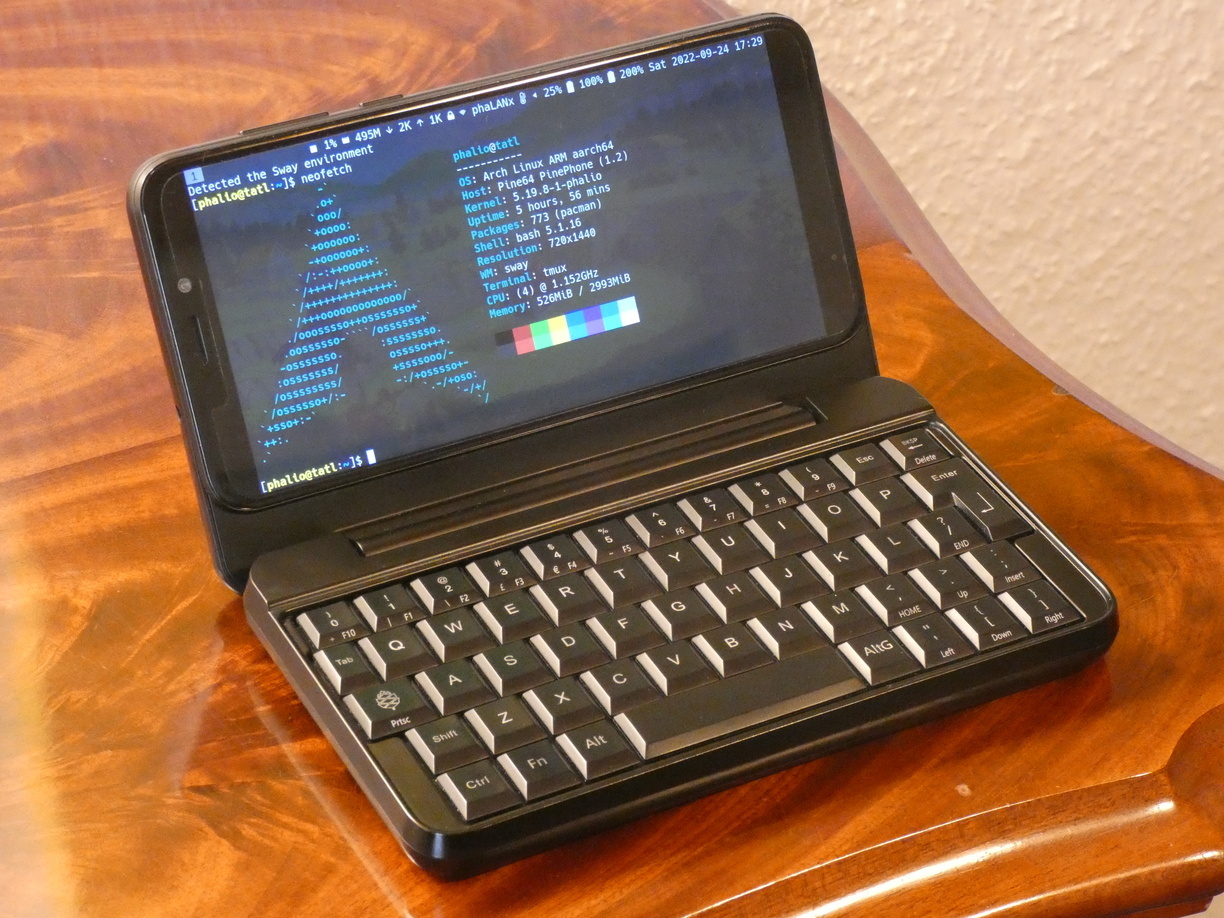Linux phones will need to run established Android apps to get users, devs won’t move where there is no users, users won’t move there if there aren’t apps. It’s almost cyclical
Right now we’re working with people who are exceptions to this, users who want to experiment and devs who don’t care about money.
Waydroid runs decently on the pinephone. On a phone with better specs, it might be downright usable for proprietary apps.
Potentially a proton-style layer could really ease transition, like on the steamdeck
BlackBerry 10 was actually a pretty slick OS that supported Android apps and you could even side-load Google Play services.
I worked in supporting those and I had an easier time helping people with windows phones. 🤢
Problems with BES?
Yes!
Potentially a proton-style layer could really ease transition, like on the steamdeck
But if people still use proprietary software, then what’s the point? Steam OS is a proprietary operating system. Is that really what we want?
Progressive Web Apps. Web programs broke the need for Microsoft Windows.
But they’re talking mainstream support and windows is much more popular.
Agreed. Classic story that has been repeated several times over the years. Ecosystem is everything.
Microsoft’s Windows phones were fantastic. They had super nice hardware, high refresh rate screens, better cameras on their flagship models than iPhones at the time.
They were sleek, fast, the Windows tile UI actually worked great on a phone touchscreen. But it didn’t matter to most consumers because they didn’t have apps. MS had their own business apps…and that was about it. Didn’t matter that every other aspect of the phones were great, people couldn’t do what they wanted to on the Windows phones, so they didn’t buy them.
I would love to see something like Proton but for .apks instead of Windows executables. If it were as easy to install and run android apps on a mobile Linux OS as it is now to install and play Windows games on Linux, we would be in a great place to see a proper Linux phone.
GNU/Linux is not aimed at people who want the most features. It’s made for people who value freedom above everything else.
I would love to see something like Proton but for .apks instead of Windows executables. If it were as easy to install and run android apps on a mobile Linux OS as it is now to install and play Windows games on Linux, we would be in a great place to see a proper Linux phone.
You mean Waydroid? I’ve read that it works pretty well.
Depends, waydroid emulates a whole android system, whereas wine translates system calls.
You are right. But it seems to be just as easy to use.
We need proton for Android apps
We have Waydroid which is close enough. It needs some quality of life improvements for better integration with the native Linux ecosystem but it runs Android apps just fine on Linux phones.
That’s just a Dalvik (Java) emulator, should be viable.
Absolutely yes! I think this is what killed the reasonably good Windows Phones. I liked them anyway. They did what phones were supposed to do and were dirt cheap. But if you searched for any of the top 50 apps you’d find some fake BS. Like when I searched for Pandora you got an app that was nothing more than a 3-4 page summary about how Pandora was the planet in James Cameron’s Avatar.
The goal of GNU/Linux is not to make it possible to run proprietary apps (but if you really need to run Android apps you can use Waydroid). It’s to create a fully libre operating system that people can use.
hot take: No.
Linux phones just need good linux software support. And then the linux user base will switch over, and everyone who isn’t simply won’t use it.
I actually genuinely do not want android developers on linux. I refuse to pay for a launcher. My entire workstation OS is developed by volunteers. Genuinely every single android app i have ever interacted with has pretty much exclusively disappointed me. It’s just a bad ecosystem.
In the same way that the linux community doesn’t need the developers of every application ever on it to thrive amongst itself, the linux phone doesnt need android developers to develop apps for it. It just needs better support for linux applications that already exist.
The only reason I will disagree: there’s already a major FOSS ecosystem on Android. There are tons of high quality free apps that aren’t FOSS
Linux isnt even that popular on desktop, my point is that people will not move if their pre established software use case is not avaliable. I won’t. I know many people who won’t.
And if there aren’t users, there won’t be people making quality software to cover wide variety of usecases and get support, if there isn’t quality software that covers a wide variety of use cases and get support there won’t be users. You need to start somewhere, it’s why the windows phone failed. No devs, so no users, and because no users, no devs.
I still don’t see your point. You’re assuming that android users will want to use a linux phone in the first place. They don’t and they wont. And that’s fine.
The only market that the linux phone has to cater to in order to develop successfully is the existing linux desktop market. The vast majority of those people are likely to want and use a linux phone. Which will actually improve the phone. And possibly even in the future bring in android developers and apps.
I don’t understand why you’re fixing on it growing, it’s just a hardware market, system76 already exists, pine already exists, linux users already exist. We exist as a bubble in a larger space and that’s ok. That’s the beauty of the unix/linux philosophy.
Realistically this is like releasing a 10,000 dollar workstation/server cpu and then having the general public complain about it being inaccessible, even though it literally wasn’t meant for them.
I appreciate the people who daily drive pinephones. They are paving the way for when they’ll be viable alternatives for the masses. (Or verifying that they won’t be, we’ll see.)
Don’t forget all the developers working on the kernel, camera support, modem firmware, desktop environments like Phosh and others, distro devs like Mobian or postmarketOS and others, app devs who work on supporting mobile and many other developers and contributors. Even bloggers who report on updates.
Everyone saying Android is completely missing the point. I mean yeah, it runs the linux kernel, but i feel like most of yall wouldn’t call ChromeOS linux on the other hand.
The obvious connotations are privacy, choice, wayland/x11 support, a useful terminal, a rich foss ecosystem, and arch btw.
ChromeOS is Linux and even starting to become it’s own full blown distro.
ChromeOS even uses Wayland now.
LacrosBut it’s proprietary software, right?
Well yes, in the same way Android is; where it’s based on an open source version of itself. (ChromiumOS)
I’d agree with you in the context of standard (google) android.
One caveat that I’d like to highlight, though, is that for me GrapheneOS and F-Droid handily achieve the privacy and rich FOSS ecosystem parts. Useful terminal depends on your definition :) but for my use case Termux fills the void.
It doesn’t feel like Linux (you can’t even use Wifi and Ethernet at the same time for crying out loud) but for a relatively cheap low-power device, I like the flexibility.
It’s far enough from being a foot gun that I can give a Pixel 5 with GrapheneOS and some F-Droid apps to my grandmother and know she’ll have no problems. Balancing that with having enough extensibility to scratch the itch for 99% of tinkerers is a feat to appreciate in my view.
My point is really just that it is an entirely different software stack than the traditional linux experience. I cant just download the source for a standard linux app and compile it for android, it needs to be ported.
I think pinephone and librem are the closest we have gotten to a proper linux phone. But the specs suck, and the mobile optimized app ecosystem isnt there yet. Thats the point of the op meme.
I can confirm that my PinePhone runs the same software that I run on my desktop. I usually don’t even need to compile anything, since a lot of packages in Debian repo have an ARM version. Not all apps have responsive UIs and some of the old ones lack touch support, though. But that is something that keeps improving over time (GNOME 4 and libhandy for example). You can also use CLI programs if you want.
At least there’s Termux. One of the very few things saving my already limited phone experience.
“Android is already a Linux phone” They hated Jesus because he told them the truth.
But it isn’t GNU/Linux https://www.gnu.org/philosophy/android-and-users-freedom.html
… or as I’ve recently taken to calling it, GNU plus Linux
Yes, but it is Linux. OP doesn’t mention GNU.
It uses an ancient Linux kernel with millions of lines of code changed from the original.
Android devices run deprecated Linux kernels that have a bunch of proprietary binary blobs plopped onto them, so technically “Linux”, but not an easily updateable mainline kernel like most people are referring to when talking about “Linux.”
OK then call it what it is. You want a FOSS Linux phone.
Linux is FOSS. Android is based on Linux. Android is not Linux.
Uh you know that Debian isn’t just Linux either right? It’s based on Linux. The same way that Android is.
Debian is GNU/Linux and that’s what almost always people mean when they say Linux. Android is not GNU/Linux and doesn’t even use the mainline Linux kernel - just some old, heavily modified version.
Mobian or Manjaro ARM on the other hand are GNU/Linux distributions. They run the same software that you can run on your desktop distro.
Moving the goalposts. We weren’t talking about GNU. Not all Linux distributions use GNU.
Not all Linux distributions use GNU.
Almost all popular ones do.
Not in the way they’re talking.
I’m quite optimistic about a usable Linux phone in the near future, maybe 5 years from now or so. When smartphones were a new thing, it was really hard for open source projects without a major company backing them to keep up with all the new developments. Hence all the projects that died out. But innovation on smartphones has basically come to a halt these days. Sure, your phone can get a little bit faster and have round displays now, but nobody cares anymore. Nothing of all that is essential. So, give it some time, we’ll get there.
I’m optimistic about the apps and desktop environments. We have made huge progress. But the problem is the hardware support. It seems that there are very few ARM SoCs, which work well with the mainline Linux kernel. So PinePhone uses a 2010 SoC and PinePhone Pro a 2016 SoC. And after all that time and despite community’s efforts to upstream everything, the mainline support is still not complete and we still use custom kernels.
https://blog.mobian.org/posts/2023/09/30/paperweight-dilemma/
Yes, but that’s exactly my point. The need for hardware support shrinks if the hardware doesn’t change every few months. A chip from a few years ago is still very fine. That was not the case in 2009.
Ah, good point.
Okay look I get what we’re trying to say here but would it be problematic if I pointed out that Android is also running Linux?
It’s a valid point, but unfortunately your non bullshit options are limited to replacing the OS with something like Graphene or Lineage.
The powers that be REALLY want your data.
I thought you could just use the Android open source project? I thought the tracking was mostly baked into Google’s flavor of Android not the open source product
I don’t know if a phone that uses the open source version as base. Usually they build off open source or google and add in all the manufacturer/carrier bloat. For me to get off One Plus’s built in OS I had to go through this whole process on their website to get the code to unlock the boot loader.
I have lineage os as a replacement and it’s really cool. My mobile internet stopped working on it though :( my next phone is gonna roll with Graphene
lineage is significantly more polished than aosp
deleted by creator
i use Arch btw
I use GNU/Linux, or as I’ve recently taken to calling it, GNU plus Linux btw
Same, on desktop and mobile. I don’t know if it’s funny or sad that a community called “linuxmemes” can’t tell the difference between Linux, GNU/Linux and Android.
Isn’t that like claiming all Linux, Android and MacOS are just UNIX?
I mean not technically… those products use a separent kernel that has its own development path away from the Linux kernel. Linux is just a compatible Unix kernel but I wouldn’t classify it as a Unix operating system since it diverges into its own thing. Android still uses the Linux kernel not some piece of code that they developed and not some commercial Unix product
Not if they don’t share any heritage with Unix. Osx is the only one that fits the bill there.
It also counts in the other way: Apple licensed the UNIX™ trademark.
GNU is a recursive acronym for “GNU’s Not Unix!”,[6][12] chosen because GNU’s design is Unix-like, but differs from Unix by being free software and containing no Unix code.[6][13][14] Stallman chose the name by using various plays on words, including the song The Gnu.[4]: 45:30
See, this is why, yet again, Stallman was right: insisting on “GNU/Linux” is necessary in order to disambiguate between the fully-Free Software OS and bastardized half-proprietary stuff like Android.
Exactly. Even in this community and in this post people keep mixing Linux, GNU/Linux and Android. It’s crazy that even people who use this operating system are confused. Almost always when they say Linux they really mean GNU/Linux. Linux Mint or Arch Linux are GNU/Linux. But Android isn’t and it doesn’t even use the mainline Linux kernel.
The issue of freedom is a separate thing, because even most GNU/Linux distros contain proprietary software just like Android.
I guess most ppl who are supporting the gnu/linux phone are the ones who want a similar apple like features like how the prism os had promised to provide.
Android is Linux.
Modified Linux kernel, but you very well know what people mean don’t you
Every distro has a modified Linux kernel, Android is no different.
Android is the first thing I think of when I hear Linux phone
chromeos is the first thing i think of when i hear linux workstation
Well um actually a Linux workstation would be GNU/Linux and chromeos is only the Linux kernel. /s
gnu/linux is ironically a fair point in this context. But to uhm ackshually you, chromeos is technically based on chromiumos which is technically based on the linux kernel.
I think when people say “Linux phone” they mean GNU/Linux.
No. Most people mean PostmarketOS, which is Busybox/musl/Linux
deleted by creator
Fair but Ubuntu Touch is not mainline Linux. It’s a hack to get a GNU/systemd Userland working with an Android kernel (which arguably is also a huge feat)
A lot of people use Manjaro and Mobian (mobile Debian).
Sure, but PMOS is by far the most complete and “daily-ready” mobile mainline Linux distro out there. In fact I’m pretty sure both Mobian and MoA use the PMOS kernels…
I haven’t used postmarketOS, but I don’t see why it would be any better than Mobian or Manjaro (Manjaro might not be the most stable though). Maybe you are talking about Android phones, in which case you are probably right - other distros might not support those so well. postmarketOS and other distros don’t use mainline Linux, so I don’t know why you would call them that, though. For me this is the biggest flaw of GNU/Linux phones.
I know that postmarketOS developers contribute a lot in different areas, but so do Mobian developers. I think the kernel we use was initially developed by Megi.
Ah, you probably right, I think it’s more common.
I personally run ArchLinux on my PinePhone.
I’ve been daily driving Ubuntu Touch on the Fairphone 4 for over a year. I love it, even if some features are lacking. Calling and text is stable, but unfortunately Volte support is still missing. Waydroid is also working great.
I’m not sure if Ubuntu Touch is GNU/Linux, since it uses the android kernel I think. But it’s not android either.
ironically, the fact that i would genuinely rather spend my money on a pinephone as opposed to an android should go to show how little i care for android devices.
If your needs are very simple, and you’re willing to go without a lot of luxuries, then yeah, it could work for you.
I don’t know, but I was thinking PinePhone would be more useful when your needs rather aren’t simple.
Yeah, I guess specific would be a better word. Like if having a good terminal emulator and SSH client is more important to you than having access to Android apps.
it’s a fun toy, not super useful but probably fun to tinker with
I’ve done some ungodly stuff to my android phones (even non-rooted ones, I’m totally abusing them) and I can’t even imagine all the possibilities with a proper linux distro. Having a pocket pc with a full arm64 linux sounds awesomeI daily drive it, just like some other people here. It lets you run the same software that you use on desktop. Some apps don’t have a UI that works well on mobile (possible workaround: play around with scaling) and some old ones might not have touch support (you would have to use those with mouse or keyboard), but often there are mobile friendly alternatives, so it’s better to use those instead. It can’t replace a proper PC, even if you plug it into a monitor and it’s not a fast device, but it’s usable and you can do fun stuff with it. You can run CLI programs and servers, run Kali Linux (NetHunter Pro), distro hop, make hardware addons (there are some exposed pins on the back) or simply use it as phone. You just have to be an advanced GNU/Linux user, because sometimes workarounds are required.
And when you add the keyboard addon, you can look like a true hackerman:

Between October 2018 to April 2023 I used as my daily drivers a series of phones (OnePlus One, Meizu Pro 5, Volla Phone, Xiaomi Redmi Note 9 Pro) all flashed to running Ubuntu Touch. During this time UT (Ubuntu Touch) was less developed than it is now, in that Waydroid (which allows using some Android apps over a Lineage OS container that boots on top of UT) did not yet exist, and Libertine (which allows some Linux desktop apps built for Ubuntu arm64 deb to be installed) was not as functional. And yet is still worked great for my modest needs (e.g. I don’t do banking, or any kind of more advanced gaming, on my phones).
The reason I reverted last year to de-googled Android (“vanilla” Bliss ROM on a Xiaomi Redmi Note 10 Pro) is that being in the USA, the carriers here have closed or are closing down all their 3G/2G networks, and requiring VoLTE for phone calls. While UT supports LTE for mobile data without a problem, given that VoLTE is a proprietary closed protocol with implementation varying between carrier, oem and device, the only device which UT currently has VoLTE support for (and which is still shaky) is the PinePhone Pro.
Anyhoo - the UT dev community is pretty small, but definitely dedicated, and still offers some promise into the future for a nice privacy respecting alternative OS for mobile devices and tablets. Hopefully at some point VoLTE, and a few other issues gets figured out for it so I can return to using it for my daily driver - in the meantime I’ve got it on a OnePlus 5t as a secondary device, and on a Lenovo x306f 10" tablet.
The loss of Dalton Durst from that team from burnout was a big hit. They’ve been doing work on it but I haven’t seen anything approaching the output they had when he was heading it up.
Dalton is an amazing and very cool guy, and when he left it was indeed a big hit to dev speed at first, but recently a few super smart and dedicated guys have been able to do a big jump in updating the base from 16.04 to 20.04 (which involved moving from upstart to systemd) and they are getting close to rebasing to 24.04 (target for this is this June in fact). Plus Waydroid support has gotten really good in the time since Dalton moved on, and snap support is getting worked on now as well.
the only device which Ubuntu Touch currently has VoLTE support for (and which is still shaky) is the PinePhone Pro.
I’m incredulous that this is the case. You’re probably right but there’s no way in hell I’m using a phone restricted to 2g or 3g.
I am talking about VoLTE (Voice over LTE) which is the protocol just for making phone calls over 4g networks - NOT 4g/LTE mobile data! Ubuntu Touch has worked well with 4g/LTE mobile data for 10 years now.
makes sense, but there’s no carriers in the US for voice calls over 3g.
Yes, while you can still do 3g/2g phone calling in most of Europe, the only hold out in the US for this is that T-mobile still has 2g calling in some areas, but they have announced that this will be shut down sometime in the soonish future (it was scheduled to be all shutdown of April this year, but they announced this was delayed to a time tbd, likely in order to continue to serve all the ATM’s and iot devices that are still running “legacy” systems being used beyond supposed eol). Which is why I reverted to using de-googled AOSP for my daily driver - I like to be able to use my phone as a phone after all.
I hope its stable enough when i stop using my current phone
Well it is stable, but it lacks most of today’s I would call it “comfort-usability” but the main features are definitely working.
Here is a recent blog post about someone’s experience with PinePhone Pro: https://zerwuerfnis.org/daily-driving-the-pinephone-pro
I have the original PinePhone and it seems to have less issues, but it’s also slower and has a crappy camera.
Looks like for me I will have to wait for WhatsApp to be cross-app, and the phone call audio quality will be an issue.
There seems to be some progress with the call audio issue, so it might get fixed soon. As for WhatsApp you can probably run that with Waydroid (but eventually you should switch to some free software messenger).
My bad I have not phrased my sentence properly, I am already using signal and with hopes that WhatsApp allows ppl to send messages to another WhatsApp number from my preferred app here signal then I can communicate with my friends and colleagues
Is Facebook planning to do that?
That’s what one of sources that I read has mentioned about it
That’s very interesting.
also kudos to GrapheneOS social media people patiently explaining why both purism and pine64 are pretty mid at best when it comes to hardware security
What do you mean?
https://grapheneos.social/@GrapheneOS/111957964224325239
https://grapheneos.org/faq#future-devices
https://grapheneos.social/@GrapheneOS/111738765361100063
https://grapheneos.social/@GrapheneOS/111676448278523353
https://grapheneos.social/@GrapheneOS/111676423446810227
This only talks about the Fairphone. The only mention of PinePhone and Librem 5 is that according to the author providing schematics is not enough to call it “open hardware”.
No mention of PinePhone or Librem 5.
Same as above.
It’s a misconception that the Librem 5 and Pinephone are open source. Their hardware components including the CPU, GPU, Wi-Fi, Bluetooth, cellular, etc.
The word “open source” usually refer to software, but ok. Those companies provide schematics for the motherboard and Librem 5 also provides PCB designs. But they don’t provide those for the chips, so that is correct. I don’t think anyone says otherwise.
Their hardware/firmware/software is all much less private and secure
What? :D The person doesn’t even explain why. Then they talk about physical killswitches misunderstanding what they are really for (they are there so that you don’t have to fully trust the software/firmware to turn something off - especially the proprietary modem firmware) and claim that all of those devices are insecure somehow, because on GNU/Linux any program can access the microphone. But that’s exactly why we use free software, isn’t it?
I’m sorry, but this is ridiculous, so I won’t read the rest. I’m not a hardware expert, though, so maybe some of their other points were valid. I guess those phones’s hardware is probably as secure as any other computer’s. I don’t think anyone says otherwise, but the killswitches are always a good idea.
Pinephone doesn’t have features like IOMMU isolation or even verified boot. Also as a matter of fact, permission control, unless you’re using flatpak/bwrap/firejail is actually better on Android than Linux. Plus long before the first usable part of Linux written in Rust was released, large parts of low level AOSP code were already rewritten in it.
PinePhone’s modem is isolated through USB. I don’t know about other components, though.
Also as a matter of fact, permission control, unless you’re using flatpak/bwrap/firejail is actually better on Android than Linux. Plus long before the first usable part of Linux written in Rust was released, large parts of low level AOSP code were already rewritten in it.
I understand that, but none of that makes GNU/Linux insecure and that’s what the GrapheneOS developer has claimed. They said it was insecure. I can’t say if GrapheneOS is more secure than GNU/Linux, because I don’t know enough about it or how libre it is, so I’m not arguing with that. It’s possible that it is (I would have to check opinions of independent experts). My point was that those people can’t be taken seriously if they make such ridiculous claims. I don’t know if I can believe anything they say.
This person says that Android (a proprietary operating system) is more secure than GNU/Linux. Ridiculous. It’s nice that Android has all those security features, but it’s still proprietary, so can’t be trusted. Keep in mind that he didn’t just say GrapheneOS, which might be entirely free software, so unlike Android, it might have a chance to be secure.
PureOS also uses linux-libre. This will prevent the user from loading any proprietary firmware updates, which just so happens to be almost all of them.
I don’t think this is true at all. The firmware in Librem 5 is stored on some separate chips and I think users can flash new firmware to them. But even if he was correct, I’m not entirely convinced that you get a security benefit from being able to change from one proprietary firmware version to another, since both those versions can’t be trusted. I will need to read more about this at some point.
Then he says the same stupid thing about the killswitches and just like the GrapheneOS dev pretends that they have no benefit. I’m starting to wonder if they are the same person. Never mind, I can now see that he quotes him in his GNU/Linux article, so he is probably just repeating after that guy.
The microphone kill switch is useless since audio can still be gotten via the sensors (such as the gyroscope or accelerometer).
I doubt that. I’m pretty sure that in reality the audio levels you can get from those sensors is too low to be usable (unlike a microphone). Here is a fun fact that this person doesn’t know about. The microphone killswitch on one of the PinePhone versions doesn’t actually kill the microphone, it just disconnects the amplifier or something. So the microphone technically still works, but it’s not gonna pick anything up, even if you yell directly at it. I know this, because people have figured it out from looking at the schematics and tested it.
The unorthodox way in which the Librem 5 attempts to isolate the modem is via the Linux kernel USB stack, which is not a strong barrier, as shown in the Linux article.
I can’t find where he explains this, but I think the problem was that he just doesn’t know about USBGuard. The author’s two articles are full of errors or false information, they don’t understand that proprietary systems can’t be considered secure. I see no reason to trust their opinions on security.
AOSP is not proprietary. Also security is not achieved merely by the merit of being libre, see CVEs for sudo, glibc or Apache HTTP server or even the Linux kernel itself.
And when it comes to proprietary firmware updates, in case of x86 one such notable example is the microcode which is pretty important to keep updated for security.
AOSP is not proprietary.
I never said that it was.
Also security is not achieved merely by the merit of being libre, see CVEs for sudo, glibc or Apache HTTP server or even the Linux kernel itself.
Being libre is the basic requirement to even being considering something as secure, but it is not enough by itself. I agree.
And when it comes to proprietary firmware updates, in case of x86 one such notable example is the microcode which is pretty important to keep updated for security.
Generally that’s what people say, but is it really that simple? A new firmware version might fix some known vulnerability, but its developers might have also introduced a new one on purpose. So a known vulnerability might have been fixed, but you might have gotten a new one that isn’t yet known. So I don’t know if that’s really so much better. Also I assume that the only way to exploit those vulnerabilities is through malware? But if you only run free software, the risk of getting malware is very small.
Out of pocket I would assume nonfree packages and hardware shenanigans: binary blobs, etc. …
The latter imo is only really a concern if you’re being targeted hydrate actors, and you got bigger problems then
Mobian Bookworm contains 2 non free firmware packages: https://packages.mobian.org
According to the FSF, GrapheneOS also contains non free firmware:
GrapheneOS is a version of Android which is described as “open source,” but it seems to include software that isn’t free software or even “open source”. For instance, it comes with firmware programs for installation and it appears that at least some of them are binaries without source code. It is said to be “de-Googled,” but includes a way to download and install the nonfree Google Play program.
My Nokia N900 ran Linux back in the day, and was a more polished experience than the iPhone it was then contemporary with. Too bad that particular line went precisely nowhere.
Didn’t it go to Sailfish OS which technically still exists?
Not officially, from what I recall. That was possibly one of the plans for it’s alleged successor, the N950, which turned out to be vaporware. Sailfish OS then went to be used on the first Jolla Phone, which probably sold in single digit numbers. Jolla now manufactures nothing, although they apparently continue to develop Sailfish for licensing to embedded applications, and their main deal seems to be the “Appsupport” compatibility layer for Android apps to run on Linux.
















